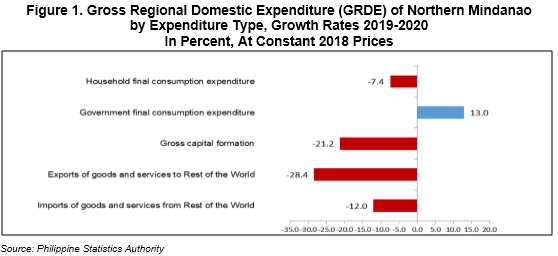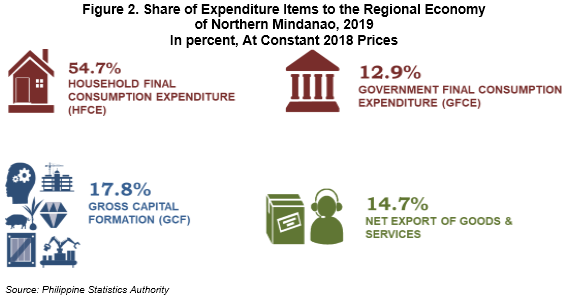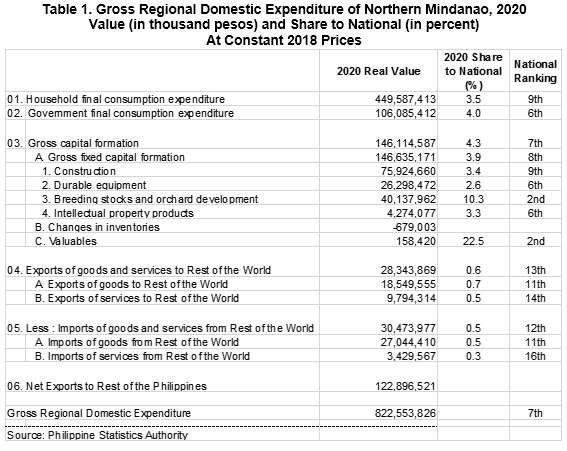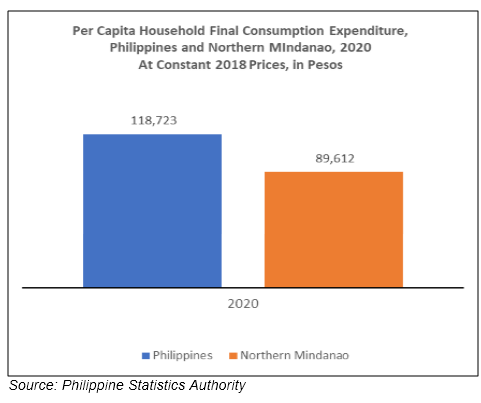With the recorded decline in Northern Mindanao’s GRDP, all major expenditure items recorded declines in 2020 except Government final consumption expenditure (GFCE). Government spending or GFCE increased by 13.0 percent, slower than its recorded growth in the previous year at 18.6 percent. Region X remained to have the fastest increase in government spending since 2019.

Household final consumption expenditure recorded a decrease of 7.4 percent in 2020. This includes final consumption expenditure incurred by resident households on goods or services to satisfy human needs and wants, and not for business purposes. The region registered the 6th slowest decline in HFCE among the 17 regions.
Gross capital formation also dropped by 21.2 percent in 2020. This includes gross fixed capital formation (construction, durable equipment, breeding stocks and orchard development, and intellectual property products), changes in inventories, and valuables. This decrease was the 9th recorded slowest contraction among the regions.
Exports of goods and services to the rest of the world decreased by 28.4 percent in 2020, ranking eighth in terms of slowest reduction. Imports of goods and services from the rest of the world, likewise, decreased by 12.0 percent, the tenth slowest decline among the regions.
Household Final Consumption Expenditure shared the bulk of the total regional expenditure
Looking at the shares of expenditures, household final consumption expenditure had the biggest share to the total expenditure at 54.7 percent, with government final consumption expenditure contributing the least share of 12.9 percent. (Figure 2)

Region X ranked second among the 17 regions in terms of share of spending in Gross Fixed Capital Formation in Breeding Stocks and Orchard Development at 10.3 percent amounting to PhP 40.1 billion. Moreover, the region ranked second in terms of share of spending in Valuables reaching PhP 0.16 billion, which constituted 22.5 percent of the total national spending in Valuables. (Table 1)

Net Exports to the Rest of the Philippines as the top positive contributor to GRDE growth
The main drivers of economic growth in the expenditure side are the Net exports to the rest of the Philippines and Government Final Consumption Expenditure (GFCE) (Table 2).

Gross Capital Formation as the top negative contributor to GRDE decline
On the other hand, expenditures which contributed most to the contraction of the region’s economy were: Gross Capital Formation with a contribution of -4.5 percentage points and household spending with -4.1 percentage points (Table 3).

Real per capita HFCE decreased by 8.5 percent
Real per capita HFCE, which is the amount of household spending per person, decreased by 8.5 percent in 2020. The real per capita HFCE in the region was recorded at PhP 89,612 in 2020, lower by 24.5 percent from the national level real per capita HFCE of Php 118,723. (Figure 3)

The Gross Regional Domestic Expenditure (GRDE) measures the economic performance of a region from the perspective of the expenditures of residents of the region. This represents the final value of goods and services produced in the region during the reference period. It is defined as the expenditure of residents of the region in the domestic territory plus their expenditures in other regions, including the rest of the world.
JANITH C. AVES
(Chief Statistical Specialist)
Officer-in-Charge
SBB/BMC
For further inquiries, you may contact:
Statistical Operations and Coordination Division
Philippine Statistics Authority Regional Statistical Service Office 10
Limketkai Module-2 BPO & Cyberpark Bldg.,
Rosario Crescent, Limketkai Center, Cagayan de Oro City
Email: psaregion10@gmail.com

